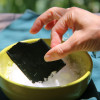While an American consumes an average of 2,500 calories (2.5 kcal) per day and a French 2300, a resident of Okinawa only absorbs 1800. However, there is no trace of malnutrition among these centenarians.
The miracle of Okinawa on longevity
Food and cooking are important in the Okinawan culture. This people practice caloric restriction, without deprivation but without excess, without taking a gram of overweight, thus hindering the process of aging. They practise a cultural habit called "hara hachibu" which consists of not eating until fullness, as one tends to do in Europe or other countries of the world.
This study on the way of life of the centenarians of Okinawa is related to work carried out on many different animal species, including monkeys. The conclusion of this work: calorie restriction without nutritional deficiency, increases life expectancy.
In 1935, Clive Mccay, vet of Corneell University in the State of New York, published an article in which he reported that he had found a way to extend the life of rats he was testing. By reducing the number of calories in their diet from 30 to 40 per cent, while enriching it with vitamins and minerals, it had allowed these animals to live from 20 to 40 per cent longer than their congeners. Caloric restriction tests subsequently gave the same results in almost 50 species, from rodents to invertebrates and fishes.
Nutritionally balanced hypocaloric diets therefore increase the average life expectancy of the different species for which a kind of functional rejuvenation is present.
The more we eat and the more waste we produce from burning food. For example, an excess of carbohydrates (bread, pasta, potatoes, etc.). results in humoral content (in blood and organic fluid) too high in lactic, pyruvium, ceto-glutamic, and sero-mucoid acids, residues of carbohydrate metabolism.
This additional waste will cause accelerated cellular overactivity and weakening, which will be followed by an increase of tissue and cell renewal, inducing amplification of DNA mutations.
Cancer risks will be promoted in the organ most involved in the metabolism of the food concerned.
There is also an increase of free radicals that alter cell membranes, as well as the very constituents of the cell, such as mitochondrias, kind of cellular energy plants. Over the years, these provide less and less energy.
Moreover, increasing oxidative stress by increasing free radicals will promote all kinds of degenerative diseases.
It is highly likely that, in addition to the calorie restriction, Okinawans benefit from a much healthier diet than Americans or Europeans, whose diet is largely charged with various toxic chemical molecules: additives, preservatives, fertilizers, pesticides, herbicides, etc. The current practice of taking food between meals, snacks, also contributes to accelerating cell aging.
Consuming fewer calories does not mean eating less in volume.
Experiments have shown that in a meal, to feel satisfied, we are more sensitive to the weight or volume of food than to their calorie density. It is interesting to know that after refinement the white flour lost 95% of its original E vitamin, 87% of its B6 vitamin, 85% of its magnesium and 78% of its fibers. However, the transformation of a wheat grain into white flour multiplies by 6 its caloric density.
More than 50% of the calories swallowed by French people come from refined cereals and added sugar. To be satisfied with meals including foods carved in nutrients and having lost their volume by refining, more calories must be accumulated.
For example, a hamburger with cheese weighs only 100 g but brings 280 calories, while a traditional Okinawa meal of 500 g including vegetables, full rice, and soy soup provides the same amount of calories for a volume 5 times larger, because it is rich in water, fibers, nutrients, vitamins, minerals and trace elements.
Despite their weight, these foods contain fewer materials or calories and generate fewer cellular transformations and less waste.
The food of the Okinawans is mainly composed of fruits and vegetables, soybean dishes, cereals, a little fish three times a week. There are very few other animal origin products. Intakes of alcoholic beverages are moderate.
Unfortunately, the youths of Okinawa tend to no longer adopt the same lifestyle than the previous generation, especially in terms of food; the number of pathologies tends to increase significantly, as in the rest of Japan. We are witnessing an increase in fast-foods in Okinawa.
The majority of "modern" foods (pizzas, hamburgers, sodas, fine bread and cereals, chocolate bars) have high caloric density but are poor in nutrients. To be full with such meals, it is necessary to accumulate calories and waste inherent in their digestion (the volume and concentration of nutrients influence satiety).
An example of balanced meals
One day I invited a friend for the evening meal. The menu prepared with organic foods was as follows:
• grated carrots with a coffee spoon of virgin walnut oil;
• a plate of red lentils;
• two soft-boiled eggs;
• some cooked vegetables in ratatouille.
One hour later, very surprised, he told me that it was the first time in a long time that after a meal, he did not feel the desire to eat again, what he was accustomed to, because of his important consumption of refined foods.
Regardless of the diet, the concept of moderation that has just been studied in this article, combined with the concepts of quality, food balance and individualization, contributes to a high level of health and energy.
Information about the author.
Eric Darche/ Hygienist-Naturopath, author of 9 works, lecturer.
Creator of an online naturopathic and hygienist school: ENHED
Office consultations at Auzon, in Auvergne or by Skype or by tel : 09 50 24 05 34.
Facebook: Naturopathie, hygiéniste et alimentation vivante.
Instagram: ecole_naturopathie_enhed





